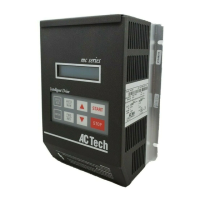38
NOTE: If TB-13A, TB-13B, and TB-13C are all programmed to select speed
references, and two or three of the terminals are closed to TB-2, the higher terminal
has priority and will override the others. For example, if TB-13A is programmed
to select 0-10VDC, and TB-13C is programmed to select PRESET SPEED #3,
closing both terminals to TB-2 will cause the drive to respond to PRESET SPEED
#3, because TB-13C overrides TB-13A.
14.2.7 ANALOG OUTPUT SIGNALS
There are two terminals that can supply analog output signals proportional to
output frequency or load. Terminal TB-10A can provide a 0-10 VDC or a 2-10
VDC signal proportional to output frequency, and TB-10B can provide the same
signals proportional to load. The 2-10 VDC signals can be converted to a 4-20 mA
signal using a resistor in series with the signal such that the total load resistance is
500 Ohms. See Parameters: 42 - TB10A OUT, 43 - @TB10A, 44 - TB10B OUT,
and 45 - @TB10B in Section 18.0 - DESCRIPTION OF PARAMETERS.
NOTE: These analog output signals cannot be used with “loop-powered” devices
that derive power from a 4-20 mA signal.
14.2.8 DRIVE STATUS OUTPUT CONTACTS
The control board has one Form C relay at terminals TB-16, TB-17, and TB-18.
Contacts are rated 2 amps at 28 VDC or 120 Vac.
There are also two open-collector outputs at terminals TB-14 and TB-15. The
open-collector circuit is a current-sinking type rated at 30 VDC and 40 mA
maximum. An external power supply (30 VDC max) must be used to power the
open-collector outputs. The drive does not have a dedicated power supply for the
open-collector outputs.
The Form C relay and the open collector outputs can be programmed to indicate
any of the following: RUN, FAULT, /FAULT (INVERSE FAULT), LOCK
(FAULT LOCKOUT), AT SPEED, ABOVE #3, I LIMIT (CURRENT LIMIT),
or AUTO/MAN. See Parameters: 52 - TB14 OUT, 53 - TB15 OUT, and 54 -
RELAY. Refer to Section 6.2.5 for a complete description of each of these status
indications.

